About 18 months ago I published an article here that I would summarize as “supermarket sprawl”. Much as I hate the word “sprawl” for its tendency to weigh down a socioeconomic phenomenon with judgment—since it implies that all decentralizing is bad and deserves to be challenged—a more neutral term is “decentralization”, which is what I typically use. In the case of grocery stores in general (and certainly the topic of my old article), an even better term might be “hopscotching”, at least when it comes to supermarkets. Because, last May, I chronicled the location, relocation, and re-relocation of a single Kroger on the far south side of Indy (never Greenwood) over the course of about 25 years. Four different sites in that time, and each of the subsequent three were new construction for Kroger. (For all I know, so was the first.) In many cases, the move was only several hundred feet away, so, even though “retail follows rooftops”, it really wasn’t about chasing down the perfect market. Kroger just wanted a shiny new building. Why would America’s largest grocery chain show such indecision? Does supermarket architecture become obsolete that quickly?
I’m not sure I can answer that question any more effectively than to conclude: “Business models change”. And, in an environment where local governments disburse building permits with little hesitation, a heavily capitalized enterprise like The Kroger Company can simply construct a new building for less money than to renovate the old, thereby ensuring continuity of operations (no customers maneuvering through a partially renovated building) and the exact specifics for what the business needs to operate with maximum productivity and profit. Another Fortune 500 company, Target, has engaged in similar “hopscotching” in metro Indy: nearly all the locations it opened in the 1970s and 80s have closed, so Target can open a bigger, better version just a few miles away. In its defense, Target, an all-purpose “upscale discounter”, doesn’t move as frequently as Kroger, and the jumps are much greater distances than my southside Indy example. So Target probably genuinely was chasing a more lucrative submarket, while Kroger just burns through its real estate.
If Kroger and (to a lesser extent) Target are guilty of hopscotching, what about chain gyms?
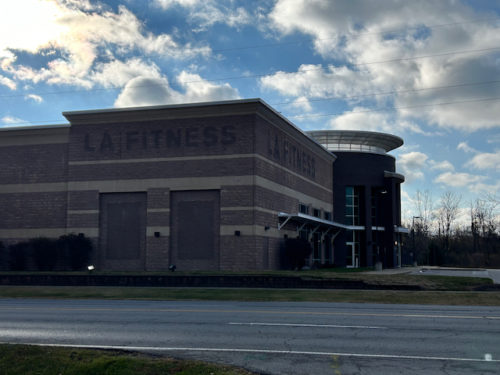
The labelscar of LA Fitness reveals what took place: earlier this summer, the Southport branch of the popular chain closed, several months after the closure of the Glendale LA Fitness location. From what I can tell, metro Indy still has eight fully functional LA Fitness gyms, and I don’t believe the corporate model is one of general retraction. They open and close as is needed.
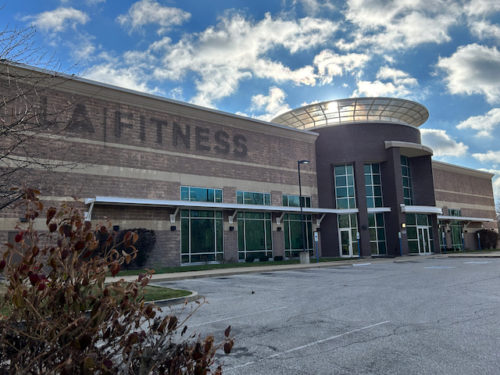
This Southport location followed a typology common to most Indy-area locations, most of which broke ground in the late 2000s. The company seems to love that cylindrical atrium, which was super trendy around 2007. Most branches in the Indy area (nearly all of which were new construction) are two floors, with most weight equipment, lockers, aerobic rooms, basketball/racquetball courts, a kids club, and a swimming pool on the main level, while a second floor loft features the majority of the cardiovascular equipment. In other parts of the country, where LA Fitness expanded before it did in Indiana, the corporation shows more flexibility: it might operate on a single story, or in a basement, or across three floors. LA Fitness corporate also willingly leases space in larger retail structures.
In Indy, the Southport location in these photos was quite popular throughout the 2010s, primarily because it was less than a mile off of the Interstate 65. It served a broad swathe, including anyone commuting between downtown and the expanse of southside communities: Perry and Franklin townships, Southport, Greenwood, Whiteland, Franklin. Some downtown workers who had no real connection to the south side of Indy would still opt for Southport for a lunchtime workout because it wasn’t a terribly burdensome drive—excluding rush hour, it was usually manageable in 10 to 15 minutes.
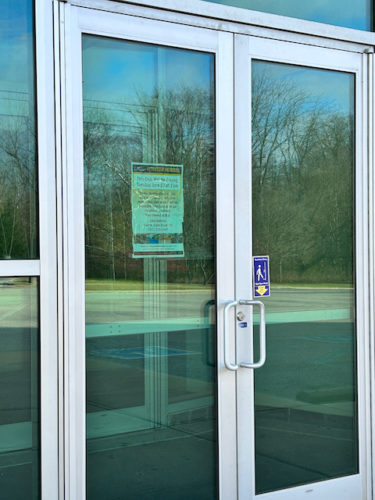
The Southport location’s 2023 closure forced its members to continue at the next closest operation: in this case, Greenwood, on south State Route 135. The Greenwood branch of LA Fitness is a tiny bit newer but generally indistinguishable, with the exception that it is not as convenient from major highways. It’s further south, not reasonable for a lunchtime workout for downtown employees, and, at least until the upgraded I-69 is complete, it’s not that close to any major limited access highway. And while LA Fitness grants a “universal membership”—a higher cost that allows customers access to any LA Fitness location in the country—those customers who paid the cheaper membership exclusive to the Southport location have no choice but to migrate their membership to the Greenwood branch. Or cancel (good luck). I can only imagine this was an unpopular prospect for many people, since the two locations aren’t that close to one another, even if the interiors are almost identical.
So why did the Southport LA Fitness close? Was it falling apart? Was there a scandal or a tendency for crime? Not that I can tell. A simple conversation with a worker at the Greenwood branch indicated that the opening of a VASA Fitness, about a mile away and earlier in 2023, siphoned off enough of the customer base at the Southport that it had no choice but to close. I know next to nothing about VASA Fitness, except that it is headquartered in Utah and it’s newer on the health club scene. It’s reasonable to conclude that a shiny interior with immaculate locker rooms is likely to appeal to those seeking novelty, even if the athletic offerings are about the same as LA Fitness. The VASA Fitness location, near Beech Grove off of Thompson Road, is equally close to an interstate exit ramp (I-465 this time), and it certainly would feel fresher than the 15-year-old Southport location, which, though hardly dumpy, was starting to look a little tired.
It still seems that the Southport LA Fitness threw in the towel (pun fully intended) rather than making any effort to compete—a bizarre decision at first blush, but a closer investigation of the business model makes the move a bit less surprising. The company began, per its name, in Southern California back in 1984, largely on a principle of purchasing other older, struggling fitness clubs in the LA area, a region where the gym/fitness trend exploded well in advance of the rest of the country. The company grew outside California by 1993, then quickly moved across the Southeast and East Coast, where it alternated between acquisitions and new construction. By the time it made its way to the Midwest, it was acquiring brands that had a much larger presence—well known 80s chains like Bally’s Total Fitness, which went fully defunct in 2016. Indy briefly had an old Bally’s (rechristened to LA Fitness) in the Lafayette Square area, though aging equipment and a rusted-out locker room almost guaranteed the new owner would shutter it.
When LA Fitness entered the Indy market through primarily new construction, it generated enough of a ripple to shut out many similar-sized competitors: Lifestyle Family Fitness was the biggest, but it caused Gold’s Gym to reduce its portfolio (the still operative chain no longer has any locations in Indy), and much smaller chains like Cardinal Fitness quickly bit the dust. Through much of the 2010s, the biggest health club competitor to LA Fitness in Indy consisted of two prototypes: the 24-hour fitness chain (best represented by Anytime Fitness or Snap Fitness), which is usually much smaller but allows fob-activated entry at 3am, or nonprofit health club arms of the YMCA and YWCA. But fitness trends change like everything else. The 24-hour locations, ubiquitous in the early 2010s, are now much harder to find. Meanwhile, CrossFit and HIIT (High-Intensity Interval Training) achieved enough popularity to migrate from homespun locations to a prominent feature of the larger corporate health club chains—including some locations of LA Fitness. Meanwhile, the late 2010s ushered in a popularization of independent studios for yoga, pilates, barre, and the hugely popular HIIT-spinoff Orangetheory Fitness, one of the most successful franchises of the last five years. And then of course there’s the unflappable Planet Fitness, which I’ve covered before on my own blog: a chain whose model is to lease depressed real estate (often a heavily vacant strip mall), dress it in garish purple/yellow, and lure people with rock-bottom membership rates to a facility that is strong on size but meager on diversity of equipment. Planet Fitness is probably fine to people who go a gym as a passing fancy, but inadequate for those who make a point of getting a workout at least three times a week. It’s unclear how many of these alternatives encroached on LA Fitness’s market share, but the fact that some LA Fitness branches redesigned space for a CrossFit, HIIT, or kettlebell component shows that corporate leadership has its eye on the trends.
The problem is, fitness fads come and go, like all other fads, and it’s pricey to invest in the infrastructure to support a craze that quickly flatlines then falters. This guarded behavior probably explains one other overarching feature to LA Fitness’s management: it is selective in which locations it invests and maintains. Most LA Fitness locations begin shiny and squeaky-clean, with impeccable operations and first-rate equipment. But wear-and-tear in popular health clubs quickly becomes obvious even to the untrained eye. While not everyone cares about the aesthetics of locker rooms, they do get grimy pretty quickly. Not only does LA Fitness renovate its older locations infrequently, but those that get sub-average use often struggle to get broken equipment fixed. I won’t identify the location in the photos below, but suffice it to say it became a running joke among the hapless members:
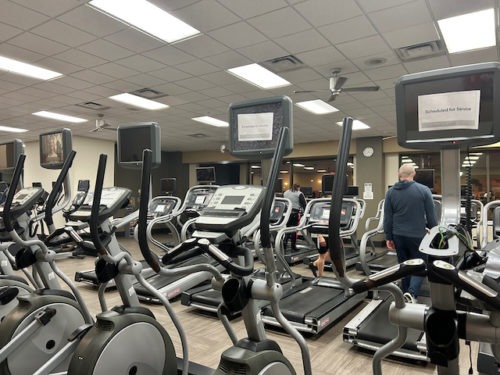
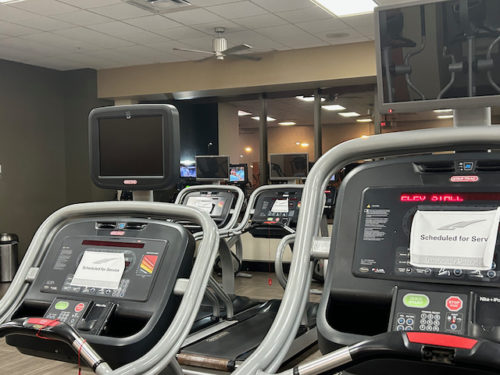
The monitors to these cardio machines have “Scheduled for Service” signs on them, but it’s not just the TV that’s broken. The whole machine doesn’t work. And in most cases, these machines stay non-operative for months. I’d estimate over one-third of the cardio machines at this LA Fitness are “scheduled for service” and the weight machines on the floor below are only marginally better. (Ostensibly this location, not in Indiana, is also closing in the weeks ahead.)
While I may just be going to the wrong locations (or the right ones), I never witnessed such disrepair or neglect at the Southport LA Fitness branch, nor any others in Indy metro. But as both a long-term member and someone who talks to others about this stuff (because it clearly interests me), I’ve been to over 30 LA Fitness locations in the eastern half of the US, and the company evidently does not have a unified vision in how it maintains its facilities or equipment. It’s selective, with some locations rating higher priority than others. This location-specific level of investment runs the risk of making the older brands seem as stale and rusty as the Bally’s at Lafayette Square. And it makes the chain more vulnerable when upstart new brands like VASA or Mei Fitness expand—or the surviving 24-hour operations (like Anytime Fitness), or Planet Fitness in a blighted strip mall.
The result? It should come as no surprise that health clubs apply a similar “hopscotching” approach to Kroger and Target, opening new locations, exhausting the real estate as the interior and its equipment ages, while adapting to some fitness trends and ceding ground to others. The Southport LA Fitness building is probably still Class A or certainly Class B, perfectly functional for a new gym chain to breathe life into it. I couldn’t poke around too much or I’d probably get in trouble, but I noticed upon peering through the window that nothing had been ripped out of the interior. The front desk is still there with equipment. Perhaps even more telling:
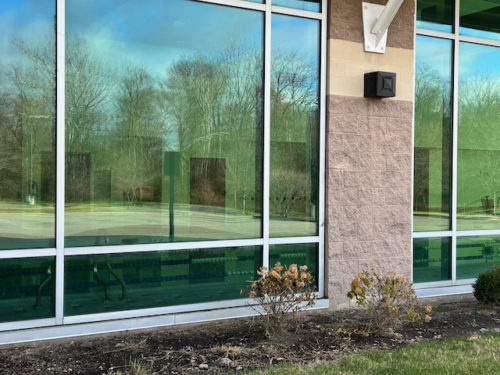
It’s hard to see through the windows’ reflection, but that’s a pool in there, and it still seems to be filled with water! It’s almost like the entity maintaining the property is just waiting for another health club to sweep in.
Will it happen? That cylindrical atrium isn’t totally old-school quite yet. But it speaks volumes that the hopscotching was already taking place long before LA Fitness took the Indy health club scene by storm. Directly across the street and up a slight slope is a massive squat building with a corrugated tin roof.
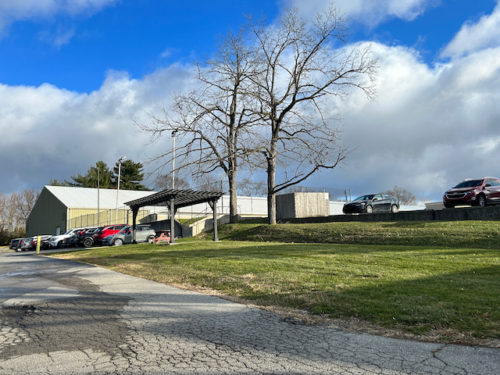
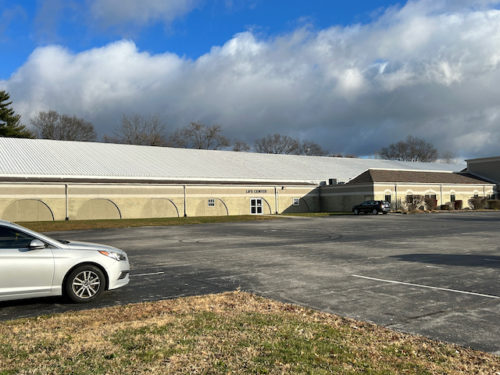
The theme of this article should enable just about anyone to guess what that building used to be, but old millennials and Gen Xers will have a bit of an advantage. Yes, it’s a former gym using the year 1990 architecture prototype. Growing up in the area, my family briefly had a membership to Racquets Four, back in a time when gyms still had Jazzercise classes, neon lights, bodybuilding trophies on a shelf, and that talcum powder that gymnasts still use. (If I recall correctly, it had pummel-horses and parallel bars and lots of other gymnastics equipment that probably morphed into a growing liability.) And of course, lots of racquetball, a sport that seems to be plunging in popularity as pickle ball overtakes the nation.
I’d speculate that Racquets Four closed in the mid 1990s. The property sat vacant for several years, but remnants of its old use survive.
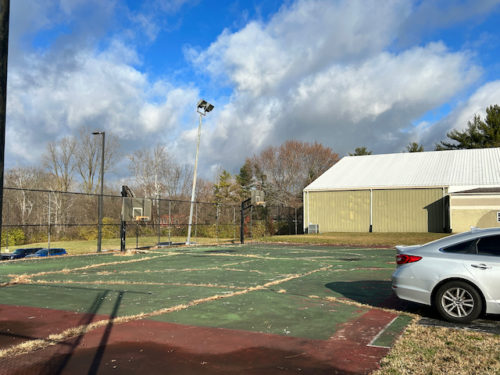
Half-court basketball is not common among health clubs today, These are clearly abandoned. And while the nets are missing, I’m surprised the rim and backboard are in such good shape. But what Racquets Four’s new incarnation?
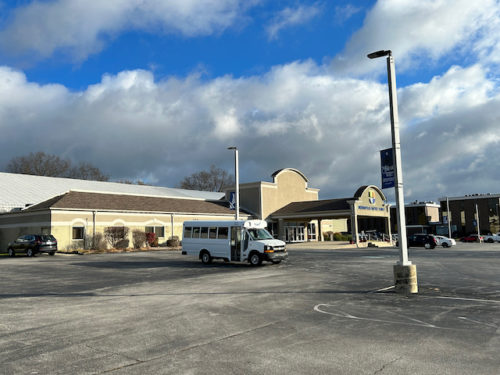
Well, it’s not exactly new, but it’s been the Indianapolis Baptist Temple for the better part of 25 years at this location. And touches upon another topic that i explored very recently in my blog: church conversions (either into a church or from a church). Through that article, I recalled a church in Raleigh that vacated, became a gym (the sanctuary was the weight room), then the gym closed and it turned back to a church. Does this mean that churches, too, are capable of hopscotching? What does a bear do in the woods?!
Places that incent and value local businesses generally don’t have these problems. By incent, I mean support. Churches generally don’t move much, either…not real churches, anyway. Mine has been in the same building since the 1880s. I left Indy for such a place because I wanted it bad enough to go find it and I didn’t want to lament the fact that my neighbors didn’t share my values for the rest of my life. There were tradeoffs, to be sure, but overall a big win. This is a smaller place, but community is much deeper than I would have guessed. People are smart, too, despite the popular perception. No Life Time. No Kroger. No Wal Mart or any other big boxes. You have to drive to get to those places and so guess what…we don’t go to them. We support the local grocer and hardware guy. No empty buildings either, because these people don’t have millions to piss away. They have skin in the game, so to speak. It’s a better model. Just sayin’.
Thanks for writing. It sounds like a very rural place, especially since towns of ~5,000 people are often still big enough to support a Walmart. Such places do still exist, and they’re probably fairly common in the Mountain West, where populations are sparse enough that it could easily be a 2-hour drive to a city of 50,000. Given those distances between settlements, its easy to justify self-sustaining, locally run grocery/hardware stores.
While market factors may have a meaningful part in hopscotching, it’s likely that municipal subsidies have a large role too. It’s very common for a municipality to give a big box development a 10-25 year tax subsidy. Those corporations that generally rely on such subsidies already have their next location (often spitting distance) in the works to phase in as the subsidies sunset on their old location.
I’ve noticed in CO that most VASA locations are in former grocery stores, so that’s kinda like lagging hopscotch. I’ve also seen Gold’s Gym and Planet Fitness in former big box retail or grocery locations.
Thanks for contributing…and you’re probably more right than I’d like to admit. I generally think of those tax subsidies/abatements (or Tax Increment Financing zones) as taking place in parts of a city that are economically underdeveloped or have suffered a great deal of disinvestment. That is not the case by any reasonable metric here in this photo example. Nonetheless, the TIF system gets abused and developers do routinely approach municipal governments with open palms, capitalizing on the notion that any new development is good development.
No other LA Fitness opened concurrent with this one closing, but a “mature” gym chain like LA Fitness seems to be more focused on purchasing other gym locations to slap on the LA Fitness brand, rather than brand-new construction, as I believe this shuttered location was about 12 years ago. If the abatements did expire, the corporate leadership may have simply seen this location as non-viable given the recent opening of VASA a few miles away, and another flourishing LA fitness location about 7-8 miles away in the suburb of Greenwood.
I didn’t know that about VASA (a comparatively “young” gym chain), but you’re definitely right that Planet Fitness operates in former (often long vacant) grocery stores. I’ve noted on my own blog that Planet Fitness kind of operates using the “Burlington Coat Factory” mentality, deliberately choosing depressed real estate in sub-optimal but high-profile locations, which no doubts help buffet the chain since it seduces new customers with rock-bottom membership rates…that are then very difficult to cancel.
I write about this subject a lot, and, coincidentally, just released another article on gym management strategy on my own blog, which is much more active than this one. Would definitely appreciate your insights! https://dirtamericana.com/2024/11/gym-sublease-martial-arts-kids-club/